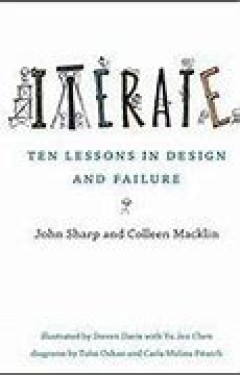Filter by

Iterate :ten lessons in design and failure
How to confront, embrace, and learn from the unavoidable failures of creative practice; with case studies that range from winemaking to animation. Failure is an inevitable part of any creative practice. As game designers, John Sharp and Colleen Macklin have grappled with crises of creativity, false starts, and bad outcomes. Their tool for coping with the many varieties of failure: iteration, th…
- Edition
- -
- ISBN/ISSN
- 9780262352123
- Collation
- 1 online resource (312 pages).
- Series Title
- -
- Call Number
- -

Empowering Users through Design Interdisciplinary Studies and Combined Appro…
At the crossroads of various disciplines, this collective work examines the possibility of a new end-user “engagement” in ongoing digital/technological products and services development. It provides an overview of recent research specifically focused on the user’s democratic participation and empowerment. It also enables readers to better identify the main opportunities of participatory d…
- Edition
- 1
- ISBN/ISSN
- 978-3-319-13018-7
- Collation
- 11 b/w illustrations, 57 illustrations in colour
- Series Title
- -
- Call Number
- -

Design for resilience :making the future we leave behind
"Designing for resilience is a critical issue of the 21st century. This is the first book-length work that shows us how to design for a future that lasts, and why we should want to"--OCLC-licensed vendor bibliographic record.
- Edition
- -
- ISBN/ISSN
- 9780262374460
- Collation
- 1 online resource
- Series Title
- -
- Call Number
- -

Racism untaught :revealing and unlearning racialized design
"A workbook with ample case studies, Racism Untaught shows readers how to recognize racism in designed artifacts, systems, and experiences and moreover, how to create anti-racist design"--OCLC-licensed vendor bibliographic record.
- Edition
- -
- ISBN/ISSN
- 9780262376426
- Collation
- 1 online resource
- Series Title
- -
- Call Number
- -

Ecological by design :a history from Scandinavia
"First study to showcase the roots of ecological design in Scandinavia, arguing for the inherently connected and global nature of the environmental crisis and modern design culture, its confrontations with consumption-capitalism and the activism driving its reform"--OCLC-licensed vendor bibliographic record.
- Edition
- -
- ISBN/ISSN
- 0262370743
- Collation
- 1 online resource.
- Series Title
- -
- Call Number
- -

From ASCII art to Comic Sans :typography and popular culture in the digital age
"Through a close examination of the material and visual culture found online, Wagner offers a contextualizing historiography that takes the reader from the art of ASCII to hatred of Comic Sans. By combining design history, visual, and material culture, this book offers a new glimpse into the role of letter form and typographical structure in the history of digital culture"--OCLC-licensed vendor…
- Edition
- -
- ISBN/ISSN
- 9780262375207
- Collation
- 1 online resource
- Series Title
- -
- Call Number
- -

The hidden factor :mark and gesture in visual design
Includes index."Traditionally, graphic design communicates through image and text. Skaggs argues that gestural touch is an indespensable third element that marks nearly all visual communication, especially typography"--OCLC-licensed vendor bibliographic record.
- Edition
- -
- ISBN/ISSN
- 9780262376365
- Collation
- 1 online resource
- Series Title
- -
- Call Number
- -

Decolonizing design :a cultural justice guidebook
"Responds to the urgent call to decolonize design through powerful, incisive guidelines drawn from 15 years of lived experience. A transformative blueprint for repairing the harm caused by structural inequity through decolonizing not only our institutions, but also our thinking, and how to begin today"--OCLC-licensed vendor bibliographic record.
- Edition
- -
- ISBN/ISSN
- 9780262373142
- Collation
- 1 online resource
- Series Title
- -
- Call Number
- -

Design strategy :challenges in wicked problem territory
"Problems without apparent solutions plague the contemporary world. Roberts proposes a new "Design Strategy" to approach these wicked problems and lays out its history and evolution, its process, principles, mindsets, skillsets and toolkits that inform and guide design practice"--OCLC-licensed vendor bibliographic record.
- Edition
- -
- ISBN/ISSN
- 9780262376587
- Collation
- 1 online resource.
- Series Title
- -
- Call Number
- -

Design to live :everyday inventions from a refugee camp
The power of art and design to create a life worth living: designs, inventions, and artworks from the Azraq Refugee Camp in Jordan. This book shows how refugees use art and design to transform their living environments, restoring humanity within circumstances that seem aimed at depriving them of it. Featuring more than twenty projects created by Syrian refugees at the Azraq Refugee Camp in Jord…
- Edition
- -
- ISBN/ISSN
- 9780262366359
- Collation
- 1 online resource (344 pages).
- Series Title
- -
- Call Number
- -
 Computer Science, Information & General Works
Computer Science, Information & General Works  Philosophy & Psychology
Philosophy & Psychology  Religion
Religion  Social Sciences
Social Sciences  Language
Language  Pure Science
Pure Science  Applied Sciences
Applied Sciences  Art & Recreation
Art & Recreation  Literature
Literature  History & Geography
History & Geography